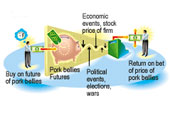| |
Polls, Markets, and Allocations
Game theory represents one important facet of decision science. In fact, decision science deals with the entire subject of markets—for goods, services, and ideas, as well as labor. NSF-funded researcher Bob Forsythe, at the University of Iowa, provides one example of efforts in this area: His innovative Iowa Electronic Market, started in 1988, offered speculators a "real-money futures market." This type of market deals with abstract, but measurable, items. Participants bet on what the price of an abstract item, such as pork bellies, will be days, weeks, or months into the future.  Between the time the bet is placed and the point at which it is paid off, the price of pork bellies will be influenced by a succession of economic and political events, including elections and the stock prices of firms in the pork industry. Between the time the bet is placed and the point at which it is paid off, the price of pork bellies will be influenced by a succession of economic and political events, including elections and the stock prices of firms in the pork industry.
Forsythe's "market" actually represented an effort to elicit more accurate information from voters than opinion polls provided. Instead of pork bellies, it focused on the electoral prospects of political candidates. "Market prices" summed up what players knew, or thought they knew, about a candidate's true chances of success in an election. Participants would win if the candidates on whom they bet were elected, and would lose if the candidates lost. Plainly, market participants could influence the result by their own votes; they would slightly improve the chances of the candidates they bet on by voting for those candidates, and slightly diminish those chances by voting for the opponents. Nevertheless, in its first ten years, the Iowa Electronic Market predicted election outcomes more accurately than did pollsters.
Recently, Forsythe and his colleagues received NSF funding to develop instructional materials that use the electronic market as a laboratory exercise to help undergraduates studying economics better understand market concepts.
In another innovative area, called "smart markets," computers have become partners in the process of making allocation decisions, such as assignments of airport landing rights and management of gas pipelines and electric distribution systems. Computers process information, coordinate activities, and monitor allocation situations historically thought to be impossible to manage with anything other than a heavily bureaucratic administrative process. For example, the results of NSF-sponsored research have been used to shape a particular type of market that sets pollution limits and allows facilities that generate pollution to trade "pollution permits" among themselves, so long as the overall limit is not exceeded.
|
|
